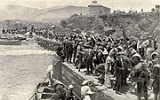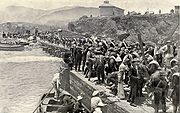
Daiquirí
Encyclopedia
Daiquirí is a small village, 14 miles east of Santiago de Cuba
. It became a focal point of the United States
invasion of Cuba
in the Spanish-American War
.
 Spanish
Spanish
General Arsenio Linares y Pombo
ordered the area from Daiquirí to Siboney
fortified in anticipation of U.S. disembarkments there. On June 20, 1898, U.S. Navy Admiral William T. Sampson
, U.S. Army General William Rufus Shafter
and Cuban General Calixto García
planned an invasion whereby the navy would shell Daiquirí, García's Cuban troops would attack the Spaniards, and, in the meantime, U.S. ships would transport some Cuban troops to Cabañas
to cut off communications and supply.
The landing two days later went almost according to plan. Sampson fired on Daiquirí, dispersing the 300 or so Spanish troops there. Some 16,000 U.S. soldiers waded ashore in the surf as the diversion at Cabañas proved highly effective. Other troops landed at Siboney, but Daiquirí continued as a storage area until U.S. forces took Santiago.
The alcoholic cocktail, the daiquiri
, was supposedly named for the area. There is an iron mine
near Daiquirí, which is a word of Taíno
origin. The cocktail was supposedly invented about 1900 in a bar named Venus in Santiago, about 23 miles east of the mine, by a group of American
mining engineers. Among the engineers present were Jennings Cox
, General Manager of the Spanish American Iron Co., J. Francis Linthicum, C. Manning Combs, George W. Pfeiffer, De Berneire Whitaker, C. Merritt Holmes and Proctor O. Persing. Although stories persist that Cox invented the drink when he ran out of gin
while entertaining American guests, the drink evolved naturally due to the prevalence of lime and sugar.
Santiago de Cuba
Santiago de Cuba is the second largest city of Cuba and capital city of Santiago de Cuba Province in the south-eastern area of the island, some south-east of the Cuban capital of Havana....
. It became a focal point of the United States
United States
The United States of America is a federal constitutional republic comprising fifty states and a federal district...
invasion of Cuba
Cuba
The Republic of Cuba is an island nation in the Caribbean. The nation of Cuba consists of the main island of Cuba, the Isla de la Juventud, and several archipelagos. Havana is the largest city in Cuba and the country's capital. Santiago de Cuba is the second largest city...
in the Spanish-American War
Spanish-American War
The Spanish–American War was a conflict in 1898 between Spain and the United States, effectively the result of American intervention in the ongoing Cuban War of Independence...
.

Spain
Spain , officially the Kingdom of Spain languages]] under the European Charter for Regional or Minority Languages. In each of these, Spain's official name is as follows:;;;;;;), is a country and member state of the European Union located in southwestern Europe on the Iberian Peninsula...
General Arsenio Linares y Pombo
Arsenio Linares y Pombo
Arsenio Linares y Pombo was a Spanish military man and government official. Born in Valencia, he earned the rank of lieutenant in 1868 and participated in operations against rebellions in Cuba, and in the Carlist Wars on mainland Spain...
ordered the area from Daiquirí to Siboney
Siboney, Cuba
Siboney is a town in Cuba east of the city of Santiago de Cuba. In 1898 Siboney and the nearby village of Daiquirí were locations where American forces came ashore in the Spanish-American War...
fortified in anticipation of U.S. disembarkments there. On June 20, 1898, U.S. Navy Admiral William T. Sampson
William T. Sampson
William Thomas Sampson was a United States Navy rear admiral known for his victory in the Battle of Santiago de Cuba during the Spanish-American War.-Biography:...
, U.S. Army General William Rufus Shafter
William Rufus Shafter
William Rufus Shafter was a Union Army officer during the American Civil War who received America's highest military decoration, the Medal of Honor, for his actions at the Battle of Fair Oaks. Shafter also played a prominent part as a major general in the Spanish-American War...
and Cuban General Calixto García
Calixto García
Calixto García e Iñiguez was a general in three Cuban uprisings, part of the Cuban War for Independence: Ten Years' War, the Little War and the War of 1895, itself sometimes called the Cuban War for Independence, which bled into the Spanish-American War, ultimately resulting in national...
planned an invasion whereby the navy would shell Daiquirí, García's Cuban troops would attack the Spaniards, and, in the meantime, U.S. ships would transport some Cuban troops to Cabañas
Cabañas, Cuba
Cabañas is a town in the Mariel municipality of the Artemisa Province, on the northeast coast in western Cuba. Prior to 1970 was a municipality of Pinar del Río Province. Cabañas bay is a harbor with industrial and fishing facilities, with an important base of the Cuban...
to cut off communications and supply.
The landing two days later went almost according to plan. Sampson fired on Daiquirí, dispersing the 300 or so Spanish troops there. Some 16,000 U.S. soldiers waded ashore in the surf as the diversion at Cabañas proved highly effective. Other troops landed at Siboney, but Daiquirí continued as a storage area until U.S. forces took Santiago.
The alcoholic cocktail, the daiquiri
Daiquiri
Daiquiri is a family of cocktails whose main ingredients are rum, lime juice, and sugar or other sweetener. There are several versions, but those that gained international fame are the ones made in the El Floridita bar in Havana, Cuba....
, was supposedly named for the area. There is an iron mine
Mining
Mining is the extraction of valuable minerals or other geological materials from the earth, from an ore body, vein or seam. The term also includes the removal of soil. Materials recovered by mining include base metals, precious metals, iron, uranium, coal, diamonds, limestone, oil shale, rock...
near Daiquirí, which is a word of Taíno
Taíno people
The Taínos were pre-Columbian inhabitants of the Bahamas, Greater Antilles, and the northern Lesser Antilles. It is thought that the seafaring Taínos are relatives of the Arawak people of South America...
origin. The cocktail was supposedly invented about 1900 in a bar named Venus in Santiago, about 23 miles east of the mine, by a group of American
United States
The United States of America is a federal constitutional republic comprising fifty states and a federal district...
mining engineers. Among the engineers present were Jennings Cox
Jennings Cox
Jennings Cox, American mining engineer who is said to have invented the drink known as the daiquiri in the late nineteenth century. Cox was an American expatriate working in Cuba...
, General Manager of the Spanish American Iron Co., J. Francis Linthicum, C. Manning Combs, George W. Pfeiffer, De Berneire Whitaker, C. Merritt Holmes and Proctor O. Persing. Although stories persist that Cox invented the drink when he ran out of gin
Gin
Gin is a spirit which derives its predominant flavour from juniper berries . Although several different styles of gin have existed since its origins, it is broadly differentiated into two basic legal categories...
while entertaining American guests, the drink evolved naturally due to the prevalence of lime and sugar.

